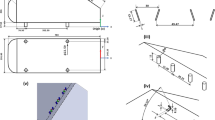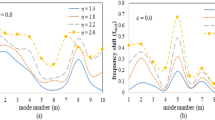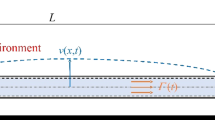Abstract
Basic equations are derived for an annular honeycomb gas seal based on a two-control volume model. The two-control volume model includes additionally a transient radial velocity component at a porous honeycomb stator surface while a conventional one-control volume model takes only the axial and the circumferential velocity components in a seal. By using a perturbation analysis and a numerical integration method, the basic equations are solved to yield the force and the corresponding dynamic coefficients developed by the seal. The two-control volume model analysis is compared to both the one-control volume model and experimental results. The comparisons show that the two-control volume analysis generally improves the predictions of rotordynamic coefficients, especially, for direct damping.
Similar content being viewed by others
Abbreviations
- b :
-
Honeycomb cell width (mm)
- C, c :
-
Direct and cross-coupled damping coefficients (N · s/mm)
- C e :
-
Nominal radial clearance at seal entrance (mm)
- C x :
-
Nominal radial clearance at seal exit (mm)
- C v :
-
Specific heat at constant volume
- d :
-
Honeycomb cell depth (mm)
- D h :
-
Hydraulic diameter (m)
- e n :
-
Surface roughness height (m)
- f :
-
Fanning friction factor
- F x ,F y :
-
Components of seal reaction force (N)
- H :
-
Local film thickness (mm)
- K, k :
-
Direct and cross-coupled stiffness (N/mm)
- L :
-
Seal length (m)
- Ma :
-
Mach number
- P :
-
Pressure (bar)
- R :
-
Seal radius (m)
- Re :
-
Reynolds number
- T :
-
Temperature (oK)
- t :
-
Time (s)
- U s ,U r :
-
Bulk-flow velocities relative to stator and rotor of Eq. (6)
- U z ,U g :
-
Fluid velocity in the axial and circum-ferential direction (m/s)
- V :
-
Fluid velocity in the radial direction (m/s)
- X,Y :
-
Rotor displacements from its static position (m)
- ε:
-
Eccentricity perturbation (m)
- π:
-
Fluid density (kg/m3)
- ω:
-
Rotor angular velocity (rad/s)
- d, b :
-
Reservoir and sump
- γ, s :
-
Rotor and stator
- z, ϕ:
-
Axial and circumferential directions
- 0, 1:
-
Zeroth and first-order perturbations
References
Childs, D. W., Elrod, D. and Hale, K., 1989, “Annular Honeycomb Seals: Test Results for Leakage and Rotordynamic Coefficients; Comparisons to Labyrinth and Smooth Configurations”,ASME Journal of Tribology, Vol. 111, Apr., pp. 293–301.
Elrod, D., Nelson, C. and Childs, D. W., 1989, “An Entrance Region Friction Factor Model Applied to Annular Seal Analysis: Theory Versus Experiment for Smooth and Honeycomb Seals”,ASME Journal of Tribology, Vol. 111, Apr., pp. 337–343.
Elrod, D., Childs D. W. and Nelson C. C., 1990, “An Annular Gas Seal Analysis Using Empirical Entrance and Exit Region Friction Factors”,ASME Journal of Tribology, Vol. 112, Apr., pp. 196–204.
Ha, T. W. and Childs, D. W., 1992a, “Friction-Factor Data for Flat Plate Tests of Smooth and Honeycomb Surfaces”,ASME Journal of Tribology, Vol. 114, Oct., pp. 722–730.
Ha, T. W., Morrison, G. L. and Childs, D. W., 1992b, “Friction-Factor Characteristics for Narrow Channels with Honeycomb Surfaces”,ASME Journal of Tribology, Vol. 114, Oct., pp. 714–721.
Ha, T. W. and Childs, D. W., 1994, “Annular Honeycomb-Stator Turbulent Gas Seal Analysis Using a New Friction-Factor Model Based on Flat Plate Tests”,ASME Journal of Tribology, Vol. 116, Apr., pp. 352–360.
Kleynhans, G. F., 1991, “A Comparison of Experimental Results and Theoretical Predictions for the Rotordynamic and Leakage Characteristics of Short(L/D=1/6) Honeycomb and Smooth Annular Pressure Seals”, Master thesis, Texas A & M University, College Station, TX.
Meirovitch, L., 1985,Introduction to Dynamics and Control, Wiley, New York, NY.
Nelson, C. C., 1985, “Rotordynamic Coefficients for Compressible Flow in Tapered Annular Seals”,ASME Journal of Tribology, Vol. 107, No. 3, pp. 318–325.
Scharrer, J. K., 1988, “Theoy Versus Experiment for the Rotordynamic Corfficients of Labyrinth Gas Seals: Part 1-A Two-Control-Volume Model”,ASME Journal of Vibrations, Acoustics, Stress and Reliability in Design, Vol. 110, No. 3, July, pp. 270–280.
Author information
Authors and Affiliations
Rights and permissions
About this article
Cite this article
Ha, T.W., Childs, D.W. A rotordynamic analysis of an annular honeycomb seal using a two-control volume model. KSME Journal 10, 332–340 (1996). https://doi.org/10.1007/BF02942642
Received:
Issue Date:
DOI: https://doi.org/10.1007/BF02942642




